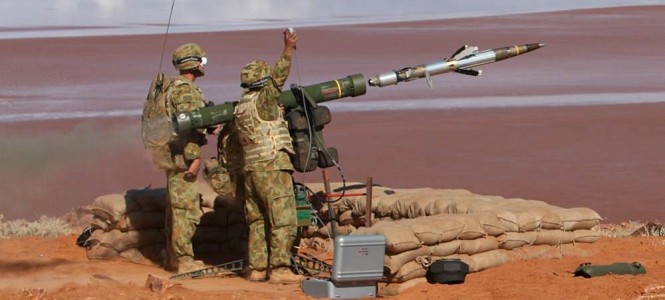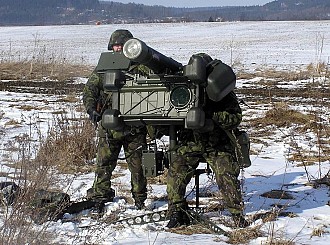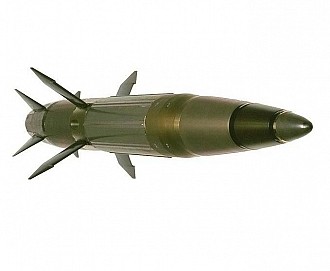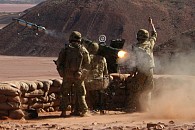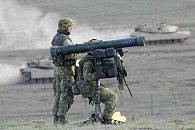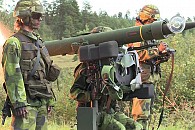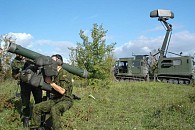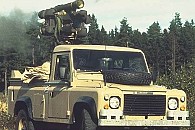Air defense / MANPADS / RBS-70
RBS-70
General Facts
- TYPE
Man portable SAM system - ORIGIN
 Sweden
Sweden - NICKNAMES
Robotsystem 70 (Swedish service)
ITO2005, ITO2005M (Finnish service) - DESIGNED
1970's - DESIGNER
Bofors - PRODUCTION
1977 - present - PRODUCERS
 Sweden - Bofors
Sweden - Bofors - QUANTITY
Unknown - UNIT COST
Unknown - CHARACTERISTICS
 High resistance against countermeasures
High resistance against countermeasures
 Good range and speed in later models
Good range and speed in later models
 Effective warhead in later models
Effective warhead in later models
 All weather capability
All weather capability
 Limited range and lethality in early models
Limited range and lethality in early models
 Manual aiming requires lot of training
Manual aiming requires lot of training
 Rather heavy for man portable system
Rather heavy for man portable system
Introduction
The RBS-70 is a modern man portable SAM system of Swedish origin. It was developed as a highly mobile system to primarily protect predefined areas, not troops on the move. The manual SACLOS guidance sets this system apart from the more common infrared homing MANPADS designs.
Layout
The RBS-70 uses a pedetal launcher on which a single operator is seated. The operator identifies targets or receives target information from mobile radar systems such as the Giraffe. The SACLOS guidance requires the operator to keep the target within the crosshairs while the missile uses laser beam riding guidance to reach the target. The laser receiver is in the tail of the missile and is very hard to jam. This required exhaust vents in the middle of the missile. The laser seeker and warhead are in the nose.
Firepower
The RBS-70 is very resistant to jamming, but requires much training to operate effectively. The orignal RBS-70 missile had a limited range of 5 km and 3 km ceiling. The limited size warhead resulted in a mediocre lethality. The Mk 2 missile has a much improved warhead, 7 km range and 4 km ceiling. The latest BOLIDE missile has a 8 km range, 5 km ceiling and Mach 2 speed.
Mobility
The RBS-70 is man portable by three men, but only over short distances. The launcher is rather heavy, especially with night sight fitted. Usually the launcher is transported in a utility vehicle or truck. The launcher can also be mounted on vehicles.
Users
The RBS-70 was first adopted by the Swedish military to realize their doctrine of mobile warfare with limited maintainance systems. The RBS-70 has been exported to a large number of nations, mainly in Europe and Asia.
RBS-70 launcher
The RBS-70 missiles are launched from a tripod launcher with a seat for the operator. The launcher is particularly important in the RBS-70 system as it houses the laser designator the operator uses to guide the missile to its target. Besides the laser designatror an IFF system and day sight are fitted on the launcher. A clip on night device can be fitted. Recently an infrared thermal sight is made available. The pedestal launcher can be fitted onto a vehicle. The RBS-70 NG (New Generation) has improved sighting systems and new training features.
RBS-70 missiles
RBS-70: Original missile, also known as the Mk 0.
RBS-70 Mk 1: Improvement over the original missile with increased range.
RBS-70 Mk 1+: A Mk 1 with improved laser seeker with expanded field of view. Effectiveness against crossing targets is much improved. Developed specifically for the Swedish forces.
RBS-70 Mk 2: Further improvement over the Mk 1 with increased range and a warhead with better armor penetration.
BOLIDE: An improved Mk 2 introduced in 2005. It has an improved rocket motor with increased speed, range and alititude. A new shaped charge warhead with prefragmented jacket is fitted. The electronics are reprogrammable to allow updates for new threat profiles.
- Specifications:
- RBS-70 Mk 0
- RBS-70 Mk 1
- RBS-70 Mk 2
- BOLIDE
| Type | Surface to air missile |
|---|---|
| Diameter | 106 mm body, 0.32 m wingspan |
| Length | 1.3 m |
| Weight | 15 kg |
| Guidance | Laser beam guidance |
|---|---|
| Warhead | HE-Fragmentation, 2.000 to 3.000 tungsten pellets, impact and 3 m proximity fuze |
| Propulsion | Single-stage solid propellant rocket motor plus ejection motor |
| Speed | ? |
| Range | 500 m to 6 km |
|---|---|
| Altitude | 5 m to 3 km |
| Engagement envelope | ? |
| Remarks | - |
| Type | Surface to air missile |
|---|---|
| Diameter | 106 mm body, 0.32 m wingspan |
| Length | 1.3 m |
| Weight | 16.5 kg |
| Guidance | Laser beam guidance |
|---|---|
| Warhead | HE-Fragmentation, 2.000 to 3.000 tungsten pellets, impact and 3 m proximity fuze |
| Propulsion | Single-stage solid propellant rocket motor plus ejection motor |
| Speed | ? |
| Range | 200 m to 6 km |
|---|---|
| Altitude | 5 m to 3 km |
| Engagement envelope | ? |
| Remarks | - |
| Type | Surface to air missile |
|---|---|
| Diameter | 106 mm body, 0.32 m wingspan |
| Length | 1.318 m |
| Weight | 16.5 kg |
| Guidance | Laser beam guidance |
|---|---|
| Warhead | HE-Fragmentation, over 3.000 tungsten pellets, impact and 3 m proximity fuze |
| Propulsion | Single-stage solid propellant rocket motor plus ejection motor |
| Speed | 580 m/s maximum |
| Range | 200 m to7 km approachting, over 4 km crossing |
|---|---|
| Altitude | 5 m to 4 km |
| Engagement envelope | ? |
| Remarks | - |
| Type | Surface to air missile |
|---|---|
| Diameter | 106 mm body, 320 mm wingspan |
| Length | 1.32 m |
| Weight | 16 to 17 kg |
| Guidance | Laser beam guidance |
|---|---|
| Warhead | HE-Fragmentation, over 3.000 tungsten pellets, impact and 3 m proximity fuze |
| Propulsion | Single-stage solid propellant rocket motor plus ejection motor |
| Speed | over 680 m/s maximum |
| Range | 250 m to over 8 km |
|---|---|
| Altitude | 5 m to over 5 km |
| Engagement envelope | ? |
| Remarks | Over 25 g maneuverability |

